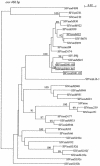Classic AIDS in a sooty mangabey after an 18-year natural infection
- PMID: 15280498
- PMCID: PMC479084
- DOI: 10.1128/JVI.78.16.8902-8908.2004
Classic AIDS in a sooty mangabey after an 18-year natural infection
Abstract
Prevailing theory holds that simian immunodeficiency virus (SIV) infections are nonpathogenic in their natural simian hosts and that lifelong infections persist without disease. Numerous studies have reported that SIV-infected sooty mangabeys (SMs; Cercocebus atys) remain disease free for up to 24 years despite relatively high levels of viral replication. Here, we report that classic AIDS developed after an 18-year incubation in an SM (E041) with a natural SIVsm infection. Unlike that described in previous reports of SIV-related disease in SMs, the SIVsm infecting E041 was not first passaged through macaques; moreover, SM E041 was simian T-cell leukemia virus antibody negative. SM E041 was euthanized in 2002 after being diagnosed with severe disseminated B-cell lymphoma. The plasma virus load had been approximately the same for 16 years when a 100-fold increase in virus load occurred in years 17 and 18. Additional findings associated with AIDS were CD4(+)-cell decline, loss of p27 core antibody, and loss of control of SIVsm replication with disseminated giant cell disease. These findings suggest that the time to development of AIDS exceeds the average lifetime of SMs in the wild and that the principal adaptation of SIV to its natural African hosts does not include complete resistance to disease. Instead, AIDS may develop slowly, even in the presence of high virus loads. However, a long-term relatively high virus load, such as that in SM E041, is consistent with AIDS development in less than 18 years in humans and macaques. Therefore, the results also suggest that SMs have a special mechanism for resisting AIDS development.
Figures




References
-
- Apetrei, C., D. L. Robertson, and P. A. Marx. 2004. The history of SIVs and AIDS: epidemiology, phylogeny and biology of isolates from naturally SIV infected non-human primates (NHP) in Africa. Front. Biosci. 9:225-254. - PubMed
-
- Beer, B., J. Denner, C. R. Brown, S. Norley, J. zur Megede, C. Coulibaly, R. Plesker, S. Holzammer, M. Baier, V. M. Hirsch, and R. Kurth. 1998. Simian immunodeficiency virus of African green monkeys is apathogenic in the newborn natural host. J. Acquir. Immune Defic. Syndr. Hum. Retrovirol. 18:210-220. - PubMed
-
- Chen, Z., A. Gettie, D. D. Ho, and P. A. Marx. 1998. Primary SIVsm isolates use the CCR5 co-receptor from sooty mangabeys naturally infected in West Africa: a comparison of coreceptor usage of primary SIVsm, HIV-2 and SIVmac. Virology 246:113-124. - PubMed
Publication types
MeSH terms
Substances
Grants and funding
LinkOut - more resources
Full Text Sources
Research Materials

